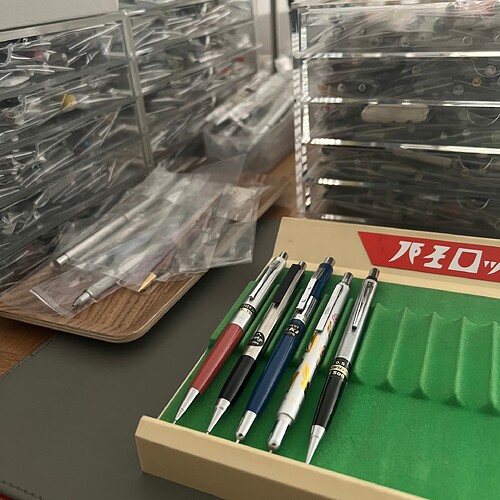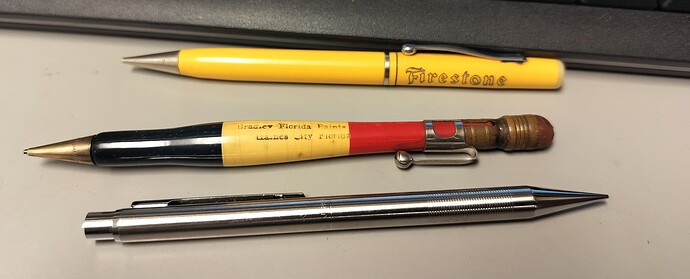This lives in my pack and comes out at work. My favorite Pentel executive style pencil, my silver-plated Scepter gets used every work day. The others come out as needed.
It seems like a fixpencil but… different. I’ve never seen that cap before
Indeed ![]() Well, the fixpencil falls under that category that many people in France and Switzerland call a Critérium. It’s one of those names belonging to a specific product that eventually becomes the name of the thing regardless of their brand, like “Gillette”.
Well, the fixpencil falls under that category that many people in France and Switzerland call a Critérium. It’s one of those names belonging to a specific product that eventually becomes the name of the thing regardless of their brand, like “Gillette”.
I know a bit of the history of these pencils because I’ve always been a fool for them. They were based on a original design by Caran d’Ache — which technically makes them all fixpencils! — but in France just before WW2 a pencil maker called Fabrique Gilbert modernised those models by introducing an “embrayage” system (French for car clutch), where you’d press the cap and the lead pipe had a step and a spring and the jaws went out to free the lead and expand and block the lead when they retract… so maybe what we now call the “clutch” is actually the name of the Fabrique Gilbert system?
During the first half of the 20th century and until the 70s, other factories in France were making these models too: Blanzy Pouré (they were making those nice raw aluminium ones, Conté (they made shorter models and also wonderful 5.6mm artist pencils) and later also BIC which I believe merged with all of them and is now the owner of that specific name Critérium which you see in supermarkets and etc.
I’m guessing this pencil is probably an off-spring from one of those factories. Maybe a test model? The lead pipe is notoriously different from the common fixpencil and “criterium” models, which I think makes it more interesting. The clutch doesn’t come out, it’s trapped inside with the spring but it all comes together nicely when you put the pipe in again. The body is lacquered aluminium (like the fixpencils and unlike the criteriums which were either from raw aluminium or plastic resin), the clip has some delicate bends and the pushbutton is truly truly nice in all its grooved glory with a sharpener inside and probably made of nickel (idk for sure…).
Really a nice piece. And according to the previous owner, quite rare.
When you compare it to all the other criteriums and fixpencils you realise there is a deliberate attempt of refinement of the very simple parts they were usually made of — so who knows, maybe this was an attempt to make a more expensive model? or a one-off? ![]()
I like both the GraphGear 500 (PG52x) and 0.4 mm leads but not the streaky grey barrel of the Japanese GraphGear 500/0.4 (PG514) so I was happy to learn about a modification. The pencil shown is based on the Graphlet 0.4 (PG504). If you remove its grip (which unfortunately isn’t non-destructive) you will find a thread on which the grip/tip of the GraphGear 500 fits (funnily enough, the thread is not needed for the grip of the Graphlet; I assume that Pentel uses the same tool for the barrel of this and the GraphGear). The clip is from the PG514 too and the button from a damaged PG525 (I would prefer to use the button of the Graphlet with the hardness indicator removed but it must be shortened to look good). I have also removed the marking. – If you take a close look at the barrel of the PG50x you’ll also notice streaks but they are much less visible than on the PG51x.
The capped pencil extender is from Stationery Program, Japan. It was made in co-operation with Kyoko Uino, the manager of the Gojuon shop and pencil museum in Tokyo (hence the laser-engraved lettering “Ginza Gojuon” and the penguin on the grip). The extender is made from ebonite which is very pleasant to the touch and holds a Pentel Black Polymer 999 HB.
Below is the Platinum Carbon pen (DP-800S). It has an amazingly smooth EF nib and uses Platinum’s carbon ink which dries quickly and is very resistant to water (which is why this ink is also very popular with urban sketchers). The unusual barrel is typical of so-called desk pens which are housed in a stand for quick access. If you keep it like this you don’t need a cap so the provided one looks like a makeshift and rather silly. Unfortunately the Platinum Carbon pen was discontinued about three years ago, and there is no worthy successor.
The fourth is the Mitsubishi/uni Jetstream 3-colour pen SXE3-507-05. I normally detest ballpoint pens, but the Jetstream is an exception (to me it’s simpy great). I also like the mechanism of that pen with the push button for the most used colour and sliders for the other two.
The tray is from the German company LYRA, but although made in Germany – where I live – I’ve never seen it here (I bought it from Bundoki, Japan, about 15 years ago).
Holy moly — I’ve been trying to get a pack of black polymers 999! Why are they so expensive?
The lead invented by Nicolas-Jacques Conté in 1795 was clay-bound which is still the standard today for woodcased pencils. In 1960 Pentel invented the thin polymer-bound lead but it wasn’t until 1986 that the Pentel Black Polymer 999, the first wood-cased pencil with a 2 mm polymer-bonded lead, was introduced. In 2011 the production ended, and although the Kutsuwa Orenpitsu and the Kutsuwa Hokusign are still available today as pencils with a polymer lead, the 999 was the first. Pentel not only had the 999 but also several other woodcased pencils, all of which were discontinued at the time (I don’t know who made them – it wasn’t Pentel). Among them was the Pentel Mark Sheet which also had a poylmer-bound lead but it’s equally difficult to find.
The Pentel Black Polymer 999 was therefore the first pencil of its kind in the more than 400-year history of the pencil and therefore has a special status (of course the mystery surrounding the actual manufacturer also contributes to this). By the way, I have compiled everything I know about that pencil in my weblog at Pentel Black Polymer 999 (in German).
Thanks!
My pleasure! – A word of caution: The Pentel Black Polymer 999 can still be found in F or harder (albeit expensive too) but is surprisingly unpleasant to use, at least to me (maybe this is the reason why Kutsuwa only offers the Orentpitsu and Hokusign in HB and softer).
Just received a batch of Zebras, including a brown Delguard which is a beauty that I’m too lazy to photograph…
This is the Karakaze01, a fully transparent high grade version of the Tect 2-way. It’s such a beauty… I’ve seen it described as the “Lite” model but I’m not sure that’s the case.
Best feature imho is the warmth of the plastic material (some sort of super nice acrylic)
It’s a fair companion to my other favourite Zebra. But actually the Karakaze has a more compact feeling than the limited edition ones.
Something about this trend of “limited editions” should be said. Despite they improve colour ways and etc, my take is that they also work in a direction of lowering the value of our collections because IMHO the real thing is the standard production line not the fashionable re-edition for collectors. For example the idk how many “meister” editions of the 925 35 exist out there, re-issuing something that should be extinct by now… It’s crazy! The original 35s have much less value now with so many 35s around.
I guess you could say the same about stamps, coins or beer cans. And now that I’ve said it — I also have to say that many LEs are absolutely amazing like this one, and they knock me right off my feet. So yeah carry on I guess ![]()
It seems that Schaeffer and Sailor released many of the same pencils.
I like it that you americans also are tempted to write Schaeffer (quite normal german name) and not the strange Sheaffer ![]()
or is this really a Schaeffer pencil??
Ha! Guilty—I took German in high school and have also spent time in Germany
Pilot Capless from the 60s, Pilot Custom NS (tuned by me because the original was super scratchy) and Pentel PSD5. I’ve been enjoying a lot the PSD5 lately.
Did TWSBI ever got to fix that lead breakage problem they had in their Precision pencils (not sure if it was in the fixed sleeve, the sliding sleeve or in both)?
Not sure how prevalent this matter might be. My 0.7 sliding sleeve has been working fine since 2016 or 17.
Currently using a Lamy xevo paired with a Schmidt modified noto. The noto was my first serious mod after discovering Isu/ The Uncomfortable Chair blog…
Also testing out the lighting at the new office. A bit too bright and cool… Already missing the high ceiling which helped to diffuse the overhead lights…











